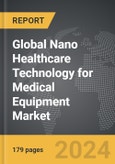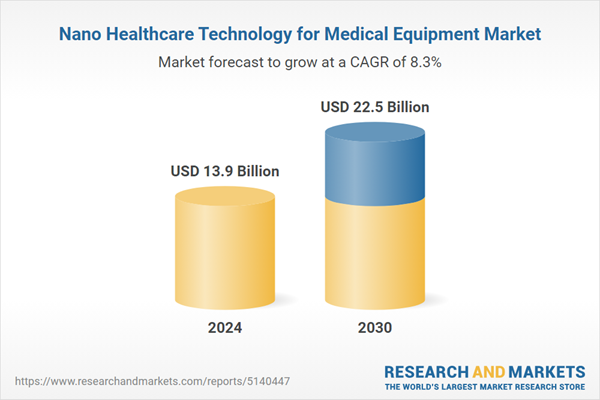Global Nano Healthcare Technology for Medical Equipment Market - Key Trends & Drivers Summarized
What Is Nano Healthcare Technology for Medical Equipment and How Is It Transforming Medicine?
Nano healthcare technology for medical equipment refers to the integration of nanotechnology into medical devices and diagnostic tools to enhance precision, performance, and treatment outcomes. Nanotechnology involves manipulating materials at the molecular or atomic scale, allowing for unprecedented control over biological processes and interactions. In the healthcare sector, nanotechnology is being applied to create more effective drug delivery systems, diagnostic tools, imaging technologies, and even tissue regeneration techniques. By incorporating nanomaterials into medical equipment, healthcare providers can improve the accuracy of diagnoses, increase the efficacy of treatments, and develop minimally invasive procedures that reduce recovery times for patients. These advancements are revolutionizing personalized medicine, enabling more targeted therapies and early disease detection.How Are Technological Innovations Shaping Nano Healthcare Technology in Medical Equipment?
Technological advancements are continuously pushing the boundaries of nano healthcare technology, particularly in the development of nanomaterials and nanoscale devices. Nanoparticles are increasingly being used for targeted drug delivery systems that can transport medications directly to diseased cells, minimizing side effects and improving treatment outcomes. Additionally, nano-coatings on medical devices such as implants and catheters are enhancing their biocompatibility and durability, reducing the risk of infections and improving patient safety. The development of nanobiosensors is another breakthrough, enabling real-time monitoring of vital health indicators through minimally invasive or non-invasive devices. Furthermore, nanotechnology is playing a pivotal role in advanced imaging techniques, such as magnetic resonance imaging (MRI) and positron emission tomography (PET), by enhancing resolution and enabling earlier disease detection at the molecular level. These innovations are driving the adoption of nano healthcare technology in both diagnostics and therapeutic applications.How Are Changes in Healthcare Practices and Patient Needs Driving Nano Technology Adoption?
The growing shift towards personalized medicine and preventative healthcare is accelerating the adoption of nano healthcare technology. Patients are increasingly expecting more tailored treatment options that minimize side effects and offer better outcomes. Nano-enabled medical equipment supports these demands by enabling more precise diagnostics and highly targeted treatments. Additionally, the rise in chronic diseases such as cancer, cardiovascular conditions, and neurodegenerative disorders is pushing healthcare providers to seek advanced treatment options that can offer greater effectiveness and lower risks. Nanotechnology’s ability to deliver drugs directly to affected areas, improve diagnostic sensitivity, and enhance the functionality of medical implants is making it a vital tool in managing these complex conditions. The increasing emphasis on early disease detection, driven by both patient demand and healthcare costs, is also fueling the adoption of nano-enabled diagnostic devices, as they allow for more accurate and earlier diagnosis of diseases like cancer, where early intervention is critical.What Are the Key Growth Drivers in the Nano Healthcare Technology for Medical Equipment Market?
The growth in the nano healthcare technology for medical equipment market is driven by several factors, including advancements in nanotechnology, increasing demand for personalized medicine, and the rising prevalence of chronic diseases. The continuous development of new nanomaterials and nano-based devices is enabling more precise, efficient, and less invasive medical treatments and diagnostics, pushing the adoption of nano-enabled medical equipment. The rising focus on personalized healthcare, where treatments are tailored to the genetic and molecular profile of individual patients, is another major growth driver, as nanotechnology plays a key role in delivering targeted therapies. Additionally, the growing burden of chronic diseases such as cancer, cardiovascular diseases, and neurological disorders is driving the need for more effective treatments and earlier diagnosis, which nano healthcare technology helps address. The increasing use of nanotechnology in drug delivery systems, medical imaging, and advanced diagnostics, coupled with strong investment in research and development, is further fueling market expansion. Finally, regulatory support for nanotechnology-based innovations in healthcare is creating a favorable environment for market growth, especially in regions with advanced healthcare systems.Report Scope
The report analyzes the Nano Healthcare Technology for Medical Equipment market, presented in terms of units. The analysis covers the key segments and geographic regions outlined below.Segments: Product Type (Active Implantable Devices, Medical Textile & Wound Dressing, Implantable Materials, Biochips, Other Product Types); Application (Diagnostics, Research, Therapeutics).
Geographic Regions/Countries: World; United States; Canada; Japan; China; Europe (France; Germany; Italy; United Kingdom; and Rest of Europe); Asia-Pacific; Rest of World.
Key Insights:
- Market Growth: Understand the significant growth trajectory of the Active Implantable Devices segment, which is expected to reach US$10.5 Billion by 2030 with a CAGR of a 8.3%. The Medical Textile & Wound Dressing segment is also set to grow at 6.6% CAGR over the analysis period.
- Regional Analysis: Gain insights into the U.S. market, valued at $3.9 Billion in 2024, and China, forecasted to grow at an impressive 7.8% CAGR to reach $3.5 Billion by 2030. Discover growth trends in other key regions, including Japan, Canada, Germany, and the Asia-Pacific.
Why You Should Buy This Report:
- Detailed Market Analysis: Access a thorough analysis of the Global Nano Healthcare Technology for Medical Equipment Market, covering all major geographic regions and market segments.
- Competitive Insights: Get an overview of the competitive landscape, including the market presence of major players across different geographies.
- Future Trends and Drivers: Understand the key trends and drivers shaping the future of the Global Nano Healthcare Technology for Medical Equipment Market.
- Actionable Insights: Benefit from actionable insights that can help you identify new revenue opportunities and make strategic business decisions.
Key Questions Answered:
- How is the Global Nano Healthcare Technology for Medical Equipment Market expected to evolve by 2030?
- What are the main drivers and restraints affecting the market?
- Which market segments will grow the most over the forecast period?
- How will market shares for different regions and segments change by 2030?
- Who are the leading players in the market, and what are their prospects?
Report Features:
- Comprehensive Market Data: Independent analysis of annual sales and market forecasts in US$ Million from 2024 to 2030.
- In-Depth Regional Analysis: Detailed insights into key markets, including the U.S., China, Japan, Canada, Europe, Asia-Pacific, Latin America, Middle East, and Africa.
- Company Profiles: Coverage of players such as 3M Company, Abbott Laboratories, AstraZeneca PLC, Ferro Corporation, GE Global Research and more.
- Complimentary Updates: Receive free report updates for one year to keep you informed of the latest market developments.
Some of the 12 companies featured in this Nano Healthcare Technology for Medical Equipment market report include:
- 3M Company
- Abbott Laboratories
- AstraZeneca PLC
- Ferro Corporation
- GE Global Research
- Merck KgaA
- PerkinElmer, Inc.
- Smith & Nephew PLC
- Stryker Corporation
- Thermo Fisher Scientific, Inc.
Tariff Impact Analysis: Key Insights for 2025
Global tariff negotiations across 180+ countries are reshaping supply chains, costs, and competitiveness. This report reflects the latest developments as of April 2025 and incorporates forward-looking insights into the market outlook.The analysts continuously track trade developments worldwide, drawing insights from leading global economists and over 200 industry and policy institutions, including think tanks, trade organizations, and national economic advisory bodies. This intelligence is integrated into forecasting models to provide timely, data-driven analysis of emerging risks and opportunities.
What’s Included in This Edition:
- Tariff-adjusted market forecasts by region and segment
- Analysis of cost and supply chain implications by sourcing and trade exposure
- Strategic insights into geographic shifts
Buyers receive a free July 2025 update with:
- Finalized tariff impacts and new trade agreement effects
- Updated projections reflecting global sourcing and cost shifts
- Expanded country-specific coverage across the industry
Table of Contents
Companies Mentioned (Partial List)
A selection of companies mentioned in this report includes, but is not limited to:
- 3M Company
- Abbott Laboratories
- AstraZeneca PLC
- Ferro Corporation
- GE Global Research
- Merck KgaA
- PerkinElmer, Inc.
- Smith & Nephew PLC
- Stryker Corporation
- Thermo Fisher Scientific, Inc.
Table Information
| Report Attribute | Details |
|---|---|
| No. of Pages | 179 |
| Published | April 2025 |
| Forecast Period | 2024 - 2030 |
| Estimated Market Value ( USD | $ 13.9 Billion |
| Forecasted Market Value ( USD | $ 22.5 Billion |
| Compound Annual Growth Rate | 8.3% |
| Regions Covered | Global |









